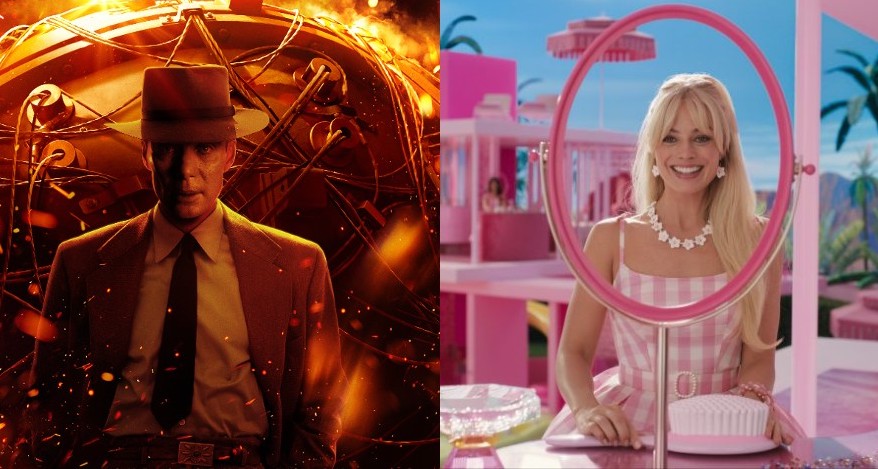Pop Culture
‘Barbie’ and ‘Oppenheimer’ Are Facing Off at the Movies and in Memes—But It’s the Unexpected Similarities That Tell Us Something About Culture Now
Underneath the warring aesthetics, the films have a lot in common.

Underneath the warring aesthetics, the films have a lot in common.

Kate Brown

I did it—I sat through a “Barbenheimer” double feature. An unofficial one anyway, and I opted for the “dinner before dessert” approach by going first to Christopher Nolan’s Oppenheimer before dosing myself with pink and plastic sing-a-longs (I can recommend this chronology, should you be so inclined).
My time in dark theaters felt a bit like a durational performance piece. For one thing, Oppenheimer, a biopic about the man who created the atomic bomb, is about three hours long and Greta Gerwig’s highly anticipated and heavily marketed film about the world-famous doll is also very long given its hole-filled plot, with credits rolling at two hours. So, between all the trailers and a strange 30-minute intermission where I watched the lobby of the theater transition from solemn Oppenheimer viewers to pink-clad Barbie-goers, I was in there for almost seven hours, nearly a full day’s work sitting in a plush chair.
Since the trailers and marketing campaign for Barbie began, the artistic spin-offs have been manifold. I’m thinking, among other things, of artist Stuart Semple making his own “Barbiest” pink color as a critique of the legal power Mattel Inc. wields over the color Pantone 219 (it does not actually hold the trademark of the color, but has tried to sue creators using it, most notably Aqua for their song Barbie Girl).
Many artists have made work about Barbie over the years—though Andy Warhol may be the only one who did it well. These artworks have resurfaced in the popular consciousness too, as Barbie fever grips the world. It has been in the air: Kasmin Gallery, though not directly in connection with the film, had a show late last year that was hosted by Mattel. The point is clear: Barbie lives in the popular conscious. And indeed, it became hard to open any window into the internet and not come across an advertisement for the film or an artistic derivative.

Left: ‘Oppenheimer ‘movie poster via Universal Studios. Right: Still from Barbie (2023). Courtesy Warner Bros. Pictures.
Because I am a millennial who once played with ill-proportioned Mattel dolls, and because I recognized at least a few of the outfits in the trailer as those I had once had in my own Barbie arsenal, I was excited, in spite of higher ideas about myself, to see Gerwig’s film. But the explosive energy thrown off by the Barbie/Oppenheimer collision is what really grabbed my attention.
In online visual culture and in meme world, the two blockbusters, which opened on the same weekend, were pitted against one another as conceptual opponents. The memetic thesis seemed to be that, on the one hand, here is a nostalgia-laced film about the world’s most ubiquitous plastic doll (which takes three cups of oil to produce) while, on the other, there’s a history-drenched drama about the man who created a weapon of mass destruction.
whoever made this is insane 😂 pic.twitter.com/mJdw36JIJz
— The Cinegogue (@TheCinegogue) June 28, 2023
The twin premiere from warring film companies merged into a portmanteau. Memes followed, which only further propelled the ongoing roll of internet commentary. The memes broke the internet: Margot Robbie, who plays Barbie’s titular girl-woman, peers over cat eye sunglasses with a coy smile in one frame beside Cillian Murphy as physicist Robert J. Oppenheimer, emerging from a mushroom cloud—an unlikely pair of horsemen for our near-apocalypse mode, in a year marked by deepening climate anxiety as well as existential fears about artificial intelligence. If you went by what the memes suggested, Barbie seemed to cry out, “everything is awful—let’s party!” while Oppenheimer bellowed “everything is awful, behold this awesome awfulness.”
The memes descended into the delightfully absurd. In one edit, someone seems to be filming an airplane sky-writing the Barbie logo against a pink sunset on their phone. Then, to the person’s right, a bomb goes off, engulfing the city and causing all its buildings to collapse. (When you do a web search for “Barbie,” Google helpfully fills your browser with a bunch of pink exploding stars—yes, even Google was trying to cash in on the trend. Oppenheimer, thankfully, has no explosive counterpart to go with it when you type the name into Google.)
But what was the juxtaposition saying? Was this a Jeff Koons-versus-Matthew Barney moment, where one is playful pop infusion that serves only entertainment with an ironic undertone, the other a self-serious epic? I wanted to see if, behind the aesthetic incongruity of this double feature billing, there was some meaning to be gleaned from all the commotion, the memes, and the sardonic fan-art (there are official t-shirts, though my favorite might be this artist-made poster). If Barbenheimer’s memes tickled some nerve in the mass consciousness, and told us something about where culture is now, it eluded me in advance of my 7-hour cinema sojourn. I hoped that seeing these two films might unlock some portal into understanding what’s going on.
This might be the best #Barbenheimer edit I've seen. pic.twitter.com/0BhzpL2xeQ
— paul atreides (@thomashelby_obe) July 9, 2023
On a structural level: The film industry is in a crisis from the pandemic, and though it’s a different beast from the art industry, and though it faces differently scaled woes, one can recognize similar fits of anxiety about how A.I. will affect creators in these industries. Actors and screenwriters are on strike. One could perhaps imagine a future where illustrators, graphic designers, critics, and maybe even artists do something similar.
Against that meta-anxiety, both these films deal with existential dread. (Oppenheimer‘s storyline wraps up in 1959, the same year the Barbie doll hit the market.) In Barbie, our hero’s awakening comes in the form of irrepressible thoughts of death, so she leaves her reality to face the real real (actual reality, not the clothes website), which shocks her in its bleak cruelty. Patriarchy still exists, Barbie finds out. The myth of progress made by women is the main theme of Barbie beyond, well, Barbie—but one could easily say it is a story about imagined progress versus the actual state of things (one could extrapolate Barbie’s narrative awakening to encompass environmental concerns, LGBTQ+ or accessibility issues, or human rights in general).
And yet, one should not easily fall into the arms of a movie that uses laughter as a way to shrug off the unsettling nature of our current world. (I think of Jonathan Coe’s 2013 Sinking Giggling Into the Sea, where he notes public laughter is a “tired Pavlovian reaction to situations that are too difficult or too depressing to think about clearly.”)
Barbie learns a lot and becomes conscious, or woke, and—spoiler alert incoming—the film concludes with her deciding to become a human, which means dying rather than living an infinite elliptical life in plastic. We have a wise Ruth Handler (Rhea Perlman), inventor of Barbie, advise the doll as she is making her choice: “Humans have only one ending; ideas live forever.” (But then, so does plastic, Mattel.)
Ideas live forever. I could think of no better segue into Oppenheimer than that line. In Nolan’s film, which begins in pre-war years, it is noted that this is a time of huge cultural development—in other words, of big ideas. A soft-spoken J. Robert Oppenheimer (Cillian Murphy) notes to politician Lewis Strauss (Robert Downey Jr.) that it is a time of revolution: in physics, yes, but also in art and culture—a time, he mutters, of “Picasso, Stravinksy, and Marx.” Modernity is blooming, and a face-off between communists and liberals presents its own kind of cultural war. Fear is used as a tactic to spur the physicists along with their bomb designs and tests.
I doubt that Christopher Nolan could have timed his movie better. We are in a parallel moment where new economic models are being proposed in crypto, and the political battleground—which is a huge theme in Oppenheimer—is tense. Art, informed by the development of technology, is changing rapidly too. I know we all are running to keep up with it and find a language to tack to it.
Early this year, podcast host Ezra Klein had a compelling podcast about the dangers and opportunities with A.I. with Vox columnist Kelsey Piper, which struck me. Piper drew parallels between the A-bomb and A.I., not in terms of destruction, but rather in terms of how, at the moment of inception, the discussions about morality that gripped experts sounded similar. Here we are again in an “arms” race during a time of war as well as a time of rampant distrust of other global power brokers.
“There are so many people, very good machine learning researchers … who nobly made the decision to not play this game because they thought they might kill us all,” Piper said, noting that these same conscientious objectors now put their energy to policies to protect the public. The sentiment tracks with the movie’s Oppenheimer and his (too-late) moral awakening in the movie, which is, not unlike Barbie, about death and reckoning with complicity in causing suffering: “Now I am become death, destroyer of worlds,” is his famous kicker, mistranslated from a sacred Sanskrit text. And Oppenheimer is a penny-drop critique of how innovation is warped by political games.
With clever moments of self-awareness of its own, Barbie manages to inoculate itself against real criticism of both its protagonist and of Mattel. It seems as if the screenwriters worked hard to acknowledge corporate power, Mattel, as something nefarious, sexist, and unfeeling—while still making a film that successful markets the doll and, as a result, the company. Will Ferrel plays an evil bossman who is also clownish (did we not see this, too, in the real world somewhere, in one recent president and U.K. prime minister?)
I saw a lot of box-checking in Barbie rather than meaningful comments about progress. And, of course, how could it be more? Just as an art fair must keep the business-as-usual jet-set happy while showing (and selling off) capitalist critique or political commentary in its booths, so does Barbie both acknowledge its problems (plastic, unfair feminine ideals, namely) before continuing on with promoting them. And while the film restores reason and feminism in Barbieland, it doesn’t offer too many solutions for the real world characters of the film, who I presume go back to their banal lives within patriarchy, or for those of us watching it.
There is a feeling of futility that pervades our current cultural universe; and it pervades the plots of Barbie and Oppenheimer, too. The fun aesthetic contrast of these two films is off the mark because, actually, they are unlikely ideological bedfellows. It’s not unlike the image by @artreviewpower100, riffing on the Barbie/Oppenheimer meme format, which shows mega-artist Damien Hirst (in pink underwear) standing in front of his cherry blossom paintings (called, as a series “The Virtues”) juxtaposed with another picture of Hirst, posing with one of his diamond skulls in stark black-and-white; with Barbie and Oppenheimer we are looking at a mood-board of the same phenomenon. After taking in Barbie‘s insider jokes and cheeky self-awareness, and Oppenheimer‘s tastefully stylized historical facts, one still feels helpless in the face of the macro problems they touch on. We get a blockbuster weekend as a coping mechanism for that which we cannot change.
More Trending Stories:
Scientists Have Developed the Whitest White Paint Ever Made—So Reflective It Can Cool Surfaces